Henadz Veratsinski: “If a photograph captures a moment, then the photographer is not its shadow — but its witness in history”
This interview is part of the collection “Voice of the Freedom Generation”, a living testimony to the creative and civic presence of those who have not lost their voice even in exile.
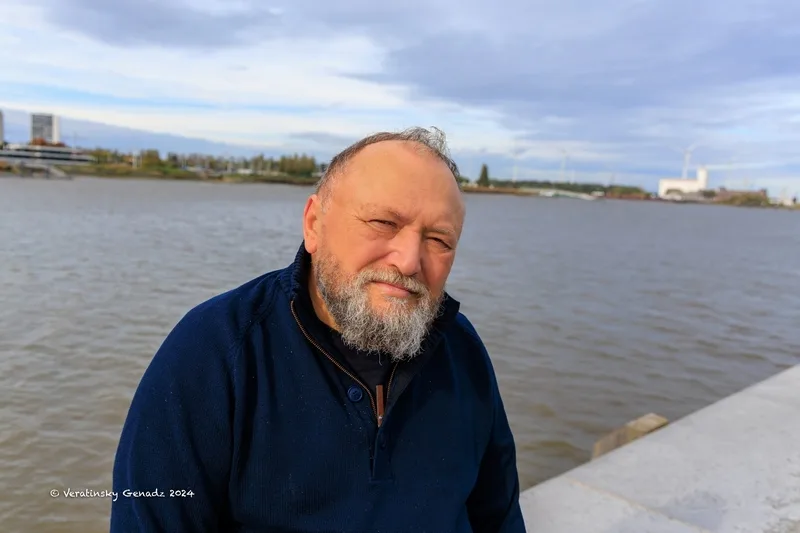
Henadz Veratsinski
The collection tells the story of the laureates of the “Voice of the Freedom Generation” award, founded by the Belarusian PEN in partnership with the Human Rights Center “Viasna”, the Belarusian Association of Journalists, Press Club Belarus and Free Press for Eastern Europe endowment fund. The collection will be presented on November 15, 2025 at 5:00 PM during a discussion with the laureates of the “Voice of the Freedom Generation” award at the European Solidarity Center (Europejskie Centrum Solidarności, Gdańsk, pl. Solidarności 1).
In Moscow, people were allowed into stores only with their passports, and in Omsk, you wouldn’t be sold a loaf of bread if you weren’t a local
Henadz, has it ever occurred to you that the click of a camera shutter is akin to the sound of a sniper’s rifle trigger?
Today, photographs, film footage, and television reports can all become grounds for severe persecution. My understanding of responsibility for what’s in the frame didn’t come right away. I was fortunate to have taken up photography at a different time. It wasn’t easy, but it was much safer. Whenever I saw something interesting, I took a picture. Everything was simpler, like cracking nuts.
The ability to observe and truly see isn’t given to everyone… In your case, was it shaped by your work as a photojournalist — assignment after assignment — or is it the result of your own intuition for stories?
I am an autonomous photo hunter. I searched for events and tracked them based on a simple principle: what, where, and when. Over time, I realized that, for many people, the camera serves as emotional support and motivation to be determined. I began to control myself so that, in pursuit of a cool shot, I would not harm anyone in it.
When the crackdown started, I removed anything that could be considered dangerous from my Facebook feed. I did so wherever possible to avoid putting people under fire. I absolutely cannot fathom why people ignore today’s political photo hygiene.
When and why did the desire arise to capture a moment in time within a single instant?
I bought my first Kiev-19 film camera in 1988. My work played a role. I traveled constantly around the USSR. It was a vast country with so much beauty everywhere. So I started with landscapes. Then the breakdown of the 1990s hit. There was no time for emotions — we had to survive. I earned money by photographing children in Gorky Park between my work trips. Then, I began teaching children in my darkroom.
If I may ask, what kind of work was that? Few people managed to travel all across the Union. Back then, people didn’t travel much — not to Europe, not even around the Soviet Union. Visits to Vilnius, Tbilisi, and Bratsk gave you emotions that were supposed to last a lifetime. People only went somewhere once every few years. Did you compare Belarus with other republics?
I happened to work on refrigerated trains. We transported food and other goods. The wheels rattled, and the landscape outside the windows gradually changed, but life hung in the balance along the assumed administrative border. By the way, our country had already become “squeaky clean” long before Lukashenka came to power. Even then, there was no model of order along the roads. As soon as you enter Russia, you’re greeted by garbage, mud, and knee-deep puddles.
When the train stopped, we would go to the store, but the shelves were empty. We didn’t even bother asking about meat or sausage. If the station shops had bread, canned food, and cheap fish, you were lucky. It was the other way around — the sellers wanted to buy something from us for their own tables: “Come on, you’re from Byelorussia!” The nineties saw a peak shortage. Even Moscow stores required passports to enter and checked registration. In Omsk, they wouldn’t sell you a loaf of bread because you’re not a local.
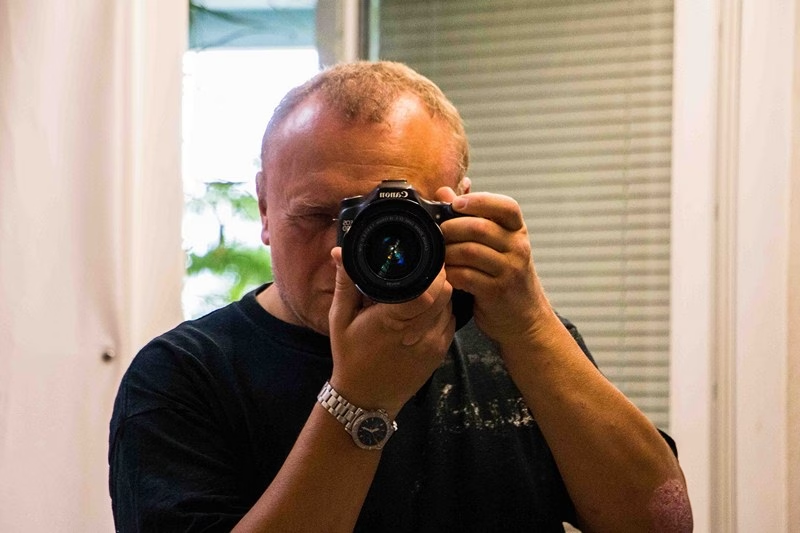
Henadz Veratsinski. Self-portrait. 2015
Did you notice any shifts in people’s attitudes or sentiments? First, sausages became unavailable, and then liverwurst disappeared. And then — unthinkable — vodka coupons were introduced. Did anger and protest energy accumulate? They were dragging us into the swamp!
Strong public apathy prevented an explosion. According to Soviet tradition, people waited for someone good to come and fix everything for them. And, in a way, they did see something arrive. After a brief outburst in Moscow in 1990, goods they had long been waiting for suddenly appeared on store shelves. As long as you had the money in your pocket, you could have it all. But everything soon returned to its former state of poverty.
It was a little different in the Union republics. People everywhere grumbled quietly that they were feeding Russia and the entire Union while receiving only crumbs themselves. When I was in Kazakhstan or Uzbekistan, the situation was worse. “We will slaughter the Russians,” some said. In Azerbaijan, it went even further. We were traveling along the Caspian Sea when the train was shot at repeatedly. The attackers demanded money and engaged in racketeering. You were supposed to pay them whenever you passed through their train stations.
Did you ever have to talk your way out of emergencies, saying something like, “Guys, I’m not Russian — I’m Belarusian!”? Did it work?
I did. Sometimes, however, the situation was escalated by fools or provocateurs. In Uzbekistan, I saw one like that — a big man with a long beard like Ivan the Terrible, shouting, “I’m Russian! If I want to, I’ll walk into anyone’s place! Close the door — I’ll kick it down with my boot.” Outwardly, only a few behaved that brutally, but perhaps that foolish feeling of being entitled lived inside many.
But we were taught for a hundred years during our childhood and youth: Kazakhs, Uzbeks, Russians, Ukrainians, Yakuts, Estonians, Lithuanians, Tatars, Bashkirs, and Belarusians are all equal; there are no differences. We read books about the new “community of Soviet people,” named streets after heroes from other republics, and printed fairy tales from different cultures — yet people lived isolated from one another. Have you thought about it?
At first, I thought we were victims of Bolshevism. Everyone: Russians and non-Russians alike. However, when I looked more closely and saw what was really happening, I changed my mind. We were all victims of the “great Russia.” The trouble came because of it, because of the Bolsheviks. Wherever they appeared, chaos, filth, and darkness followed.
What was your reason for leaving your job at the railway, where you could earn money and learn a lot of interesting things?
At that time, I received 1,000 or 1,500 roubles a month, along with travel expenses and bonuses. That was already in the nineties. But my health failed me: I almost died twice in Central Asia.
The servant editors did more than return to the tradition of Potemkin villages; at times, they surpassed their Soviet predecessors
You gradually became involved in photojournalism. Who taught you the craft? Who was your example?
I bought photography magazines, studied the pictures there, and learned from them. I was captivated by the image, as if it was a powerful magnet. I upgraded my laboratory. I educated myself, both technically and aesthetically. At that time, a new group of photographers was forming in Minsk. New communities and studios emerged, each with its own diverse interests.
So the photographic life wasn’t just limited to newspapers and magazines. It’s a much broader community!
Absolutely. A distinguishing feature is that, in addition to professional competition, there was peer support. I visited the Peoples’ Friendship House, where I found a well-equipped laboratory. Belarusfilm and Belprojekt also had people who were always helpful. It was the network of acquaintances, with one taking pictures, the second developing, and the third printing. Our love of photography, not our positions, brought us together.
Ultimately, the path of friendship must have led to another challenging endeavor: an official, more demanding editorial role.
That’s right. Through the same connections, I gained access to the editorial office of Vasil Yakavenka, a famous writer, publicist, and environmentalist. He told me a lot about the fight against land reclamation in Polesia. If it weren’t for ordinary people’s efforts, the area would have been completely drained. It’s a fact that, thanks to his direct involvement, the project to straighten the Prypiat riverbed was stopped. You can’t mindlessly fling the insulting word “Sovs”[1] at the past: both then and now, the people around you are all very different. Vasil suffered greatly in his battles with thoughtless authorities.

Henadz Veratsinski/ Self-portrait. 2024
His newspaper is worthy of recognition: it covered the Chornobyl disaster extensively. In the end, it was shut down. Did you feel captivated by editorial life?
It’s like diving into a river and getting carried away. My next harbor was with an advertising publication. I had the opportunity to learn about the printing house’s work firsthand, gain insight into design, and discover the intricacies of layout. I was soon able to prepare the issue independently, from start to finish. After that, I ended up at a serious newspaper. I got a job at Femida led by Iryna Sakalova.
One of the first human rights media outlets in Belarus. What was the team like from the inside? What was special about it?
First of all, it was about the people, who were, by and large, fascinating historical figures: Andrei Bastunets, Aliaksandr Patupa, Sabina Brylo, and Iryna herself, who is a beauty in every sense. Once, at a concert, Bulat Okudzhava[2] dedicated his songs to her and, to everyone’s amazement, gave her his guitar. Under such an editor-in-chief, the newspaper struck mighty chords.
I contributed my technical expertise to the talented team and quickly became involved in the process. I remember the day we created an issue with empty pages. Sakalova took such a step because censorship banned the materials. It was a strong message.
Why were you persecuted? What topics annoyed the authorities?
Everything that the authorities deemed “too truthful.” We reported actual legal violations, and not everyone was pleased about it. Back then, telling the truth was also considered the biggest crime. The punishment was just less severe. The reputable human rights organization PEN Belarus, headed by Carlos Sherman, published a substantial Yellow Book on the persecution of the media and freedom of speech. Femida was mentioned multiple times in the book.
The criteria and requirements for images in the media have changed in the new era. The Soviet photography school featuring smiling workers and foremen holding pennants for winning socialist competitions did not last long.
It lost because of its posed nature. What was the main thing then? To make everyone look happy. In the film Moscow Does Not Believe in Tears, there is a mocking moment when an employee recites memorized lines to the camera. The heroine’s life is dark, but there is light and smiles in the frame.
And yet it looked stunning, didn’t it? Don’t you notice the tradition of the Potemkin villages[3] today?
Let me correct that: not stunning, but pretty-ly — feel the difference. The embellishment of characters disappeared for several years, but the staff of official bodies’ editors soon restored the tradition. They’ve even enhanced it, elevating the standard for serving higher authorities with cutting-edge equipment and technology. Instead of a party card, each photographer had an editorial template and shot as required.
Near the Sports Palace, people grappled with riot police. There were screams and noise everywhere, and cars were overturned
Do you remember your most popular pictures?
Yes, I posted a series of photos titled “Lithuania” to a Lithuanian group on Facebook, and they received thousands of likes. Such feedback is unimaginable in Belarus. It may be because my perspective seemed new and fresh to Lithuanians.
Have you ever participated in a collective project, such as a photo album?
No, I’m a Facebook photographer.
This is the first time I’ve heard this…
Now you have, it’s my own description.
You see, photography is always about publicity. As with writing, taking photos without publication prospects does not work. They must be seen. Facebook gives you this opportunity: to expose, to get feedback, to feel connected. Comments, likes, and simple attention to your work are strong support. When people react, I want to keep working.
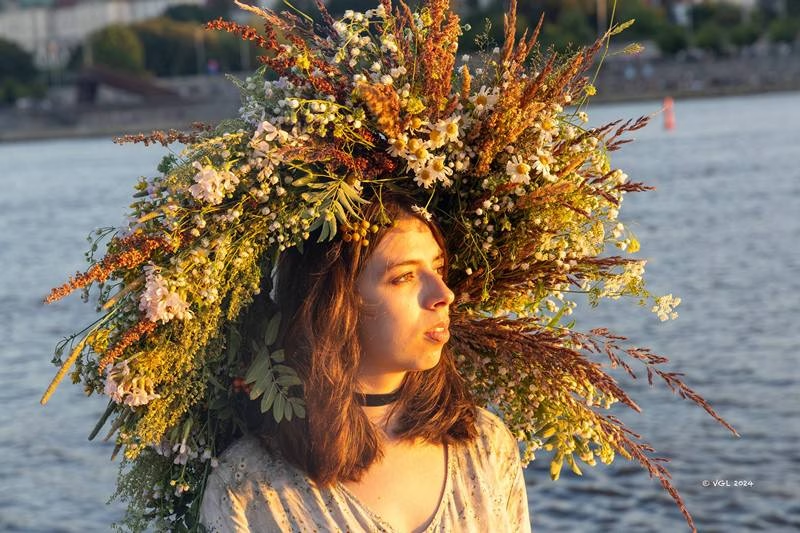
Folklore Belarusian celebration of Kupala in Warsaw. 2024. Photo: Henadz Veratsinski
Are there any specific photographers that you follow?
I’m not a narcissist in the end! For example, Dzmitry Brushko has exciting works. His father, Siarhei Brushko, documented the era of glasnost and perestroika. His every shot captures a fate, a story, an era. Without any pretense, he conveyed the character through his skill in shooting.
I am attracted to all masters with an exceptional eye for composition and an understanding of the moment.
What about Instagram? It was created for photos.
I tried, but it didn’t work. Facebook has become my platform — a familiar space that offers more communication.
Don’t you ever wish you could do more with your work? Like to have an exhibition, create an album, or participate in competitions?
I’ve never tried. I just shot what I saw. I’m comfortable behind the scenes, away from the spotlight.
Like the late Uladzimir Karmilkin, he was capturing, not inventing.
The man was a legend. He was a photo chronicler of the struggle against communism and the Lukashenka regime.
I admire this former officer’s skill at capturing the story as it is, without manipulating the light or using compositional tricks. Today, his photographs capture the essence of a hopeful era. And the evidence: documentary photography does not require effects. You can photograph a yard, a house, or people — and someday, it will all become evidence of time.
Are there people who continue this tradition today?
Even if in a different vein, yes — people are working in this field, and the results are fascinating. For instance, Dzmitry Masliy shares pictures of Minsk from the 1950s and 1970s on Facebook. Some are his own photos, and some are from archives. They get a great response.
If the unforgettable Karmilkin was the chronicler of the Belarusian Popular Front, then you are the photo-chronicler of the United Civic Party. What winds carried you there?
In 2004, after Femida, an acquaintance offered to shoot something for them. That’s how it started. At first, it was just a short-term, amateur collaboration. Then it became increasingly systemic. The party’s leader, Anatol Liabedzka, later included me in the party’s practical activities. We traveled a lot together.
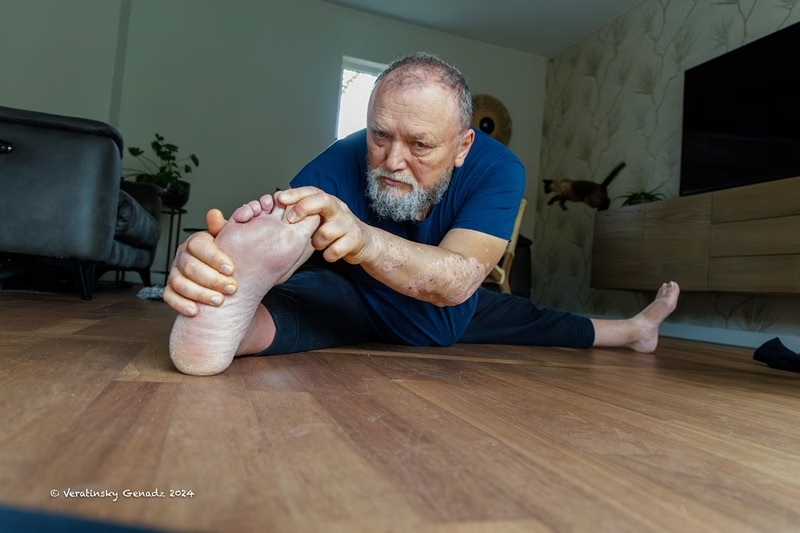
Henadz Veratsinski. Self-portrait. 2024
He’s been beaten by police more than once. If you were nearby, did you also have to take the hit?
I did. His usual approach was to distract the riot police, if he could. I remember an incident near Aliaksandrauski Garden Square. They surrounded Anatol and tried to arrest him. I rushed over to the reporters and said, “Run over there! They’re going to arrest him. Film it!” And everything was resolved. But near the Pechki-Lavochki restaurant, the ploy didn’t work. They dragged Anatol inside and beat him behind the windows where he was out of reach. Then, they took him out the back door and shoved him into a police wagon.
In 2006, Aliaksandr Milinkevich, the candidate from the pro-democracy opposition, ran for president. You worked a lot in the protest camp set up on “Kalinouski Square.”[4]
That’s right. Every morning, I went there as if I were going to work. I greeted people, took pictures, and then returned to the office in Vera Kharuzhaya Street. Day by day, I captured it all.
How did it all happen? What was going on by the tents between the white-red-white flags on the fishing rods?
It was a strange feeling. Undercover cops roamed the police perimeter while people talked, read poetry, and sang. Young men and women stomped their feet to warm up in the cold. Stepping from the subway into the crowd was like crossing a border. Inside was the territory of freedom. Despite constant detentions of volunteers carrying food and of random passersby, I felt no fear. Many of us ended up in detention after. In the camp, I instinctively felt human. But the moment you stepped outside, you were once again surrounded by surveillance and shadows.
A professional photographer must have noticed how people’s faces changed back then.
Moments of excitement made everyone look beautiful, elevated. More smiles, openness, and willingness to help. A circle of friends, no formalities, actions straight from the heart. That’s why there are so many truly excellent photos — a celebration of a free spirit.
You’ve witnessed more than one demonstration with this mind-blowing energy.
For example, the Chornobyl March of 1996. Near the Sports Palace, people grappled with riot police. There were screams and noise everywhere, and cars were overturned. It was a shocking picture at that time. Still, the security forces and judges exhibited a confident human attitude.
I was detained for the first time that same year. They brought me a community police office in Kamsamolskaya Street. A policeman named Taustamonavich was checking people’s documents and taking money from their wallets. However, it was still possible to talk to those people.
Talking is pointless with the current ones, though. Now they are robots. Without mind, without shame, without faces. They are told, so they run to follow the order.
By the way, during the “Battle on the Niamiha River,”[5] there was a rare moment of international solidarity. Quite a few Ukrainians came to support us.
Our people made it up to them. Belarusians supported their neighbors’ revolutions. When someone would criticize the fact that the Russian offensive on Kyiv began from our territory, I replied that it was necessary to distinguish between the government’s position and that of the people:
“We were on all your Maidan Revolutions, standing next to you. But when we were in trouble in Belarus in 2020, no help arrived.” I know a support train from Ukraine was planned, but it was canceled at the last moment. Perhaps, if circumstances had been otherwise, everything would have taken another course.
There is a political logic: a public person should be visible. It’s part of their job
But there are also photos of a different kind, without mass protests, stun grenades, batons, or tear gas. In these photos, only one person is standing or walking, yet the entire nation is present in that solitude, holding its dignity high. For example, pictures of Nina Bahinskaya[6] holding a flag…
This is likely the most impressive photo, indeed. One of Valer Shchukin, for instance. He alone could embody the protest. I’ve shot him many times, too. I first saw him on TV when he was an opposition Communist deputy. Then, after getting to know each other personally, I saw a completely different person. Simple, bold, sincere, open-minded. Authentic.
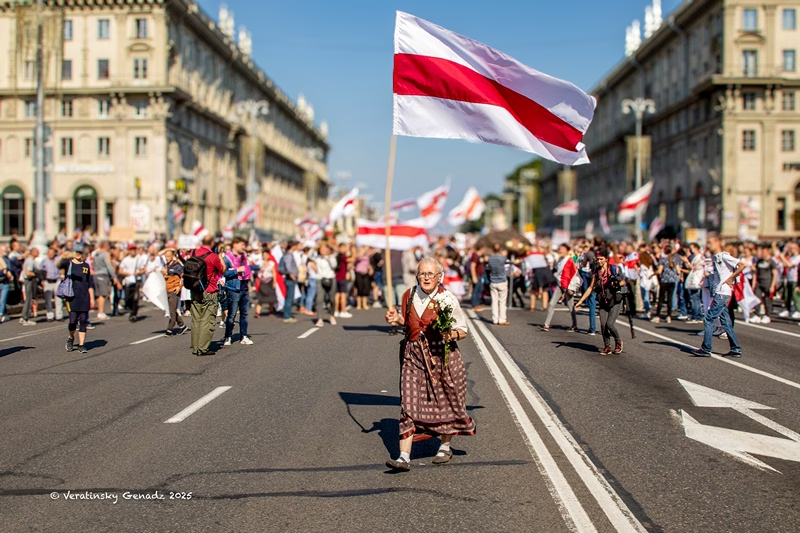
Nina Bahinskaya on Independence Avenue in Minsk. Photo: Henadz Veratsinski
What was particularly surprising about him?
Perseverance, fearlessness, and faith in justice, even in the face of overwhelming falsehood built on police violence. Three criminal cases, multiple arrests, beatings, dozens of fines — yet he stood his ground. He displayed incredible tenacity in defending his rights. For four years, he struggled against the illegal deprivation of his registration in Polatsk. So many pictures were taken by my colleagues when he spent the night at the Vitsebsk Railway Station in protest. This struggle for dignity was just one small episode in his turbulent human rights and political activities. Above all, Valer fought for a democratic Belarus, putting his own well-being last.
Where did he get all that restless energy?
It was in his nature. He just couldn’t do it any other way. Maybe he was overly emotional, but always real.
He didn’t pose for the camera?
No. Typically, when someone sees a camera lens, they tense up, smile, and pose. Shchukin behaved naturally. I understood that I was photographing him — forgive me for the tautology — not for his sake, but in the interest of a common cause. He knew that photos are often the most substantial evidence. I have many pictures of Shchukin embodying civic courage. One against the system. He was terrific in his courage. Naval officer toughness: twenty-seven years in the Pacific Fleet. And he was a real Belarusian. It’s no coincidence that he received the award from Ales Bialiatski in the “Personality” category. Performance man, action man…
For a photojournalist, people without masks, without pretension or affectation, are a treasure. The audience instantly picks up on genuine sincerity. Yet many of your subjects, with long experience in front of the camera, sensed its presence and automatically adjusted to it. For example, you have dozens of pictures of Liabedzka. Frankly, did he realize that, including through his photographs, he would secure a place in history?
I think so. But that’s not narcissism. Anatol understood the political logic: a public person should be visible. It’s part of his job. Fame isn’t the point. What’s important is the presence of your campaign, party, and cause through you.
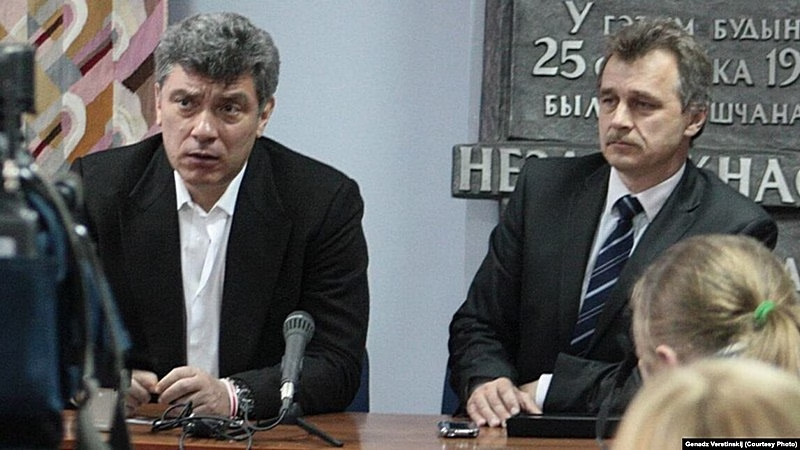
Barys Niamtsou and Anatol Liabedzka. Minsk, 2013. Photo: Henadz Veratsinski
Which of the other party members did you photograph for that very reason — because you knew they were courageous and honorable? Whose portraits were no coincidence, but rather a record of their time?
Many of them remained in Belarus, making it difficult to name them all. I don’t want to jeopardize their freedom. But I respect many people very much because they are brave, sincere, and professional. I recall Uladzimir Shantsau, a venerable figure with a resilient spirit. Maryna Bahdanovich, a courageous woman, though she and I are so different. Ludmila Hraznova, a small, intelligent woman with great dignity.
If you witness violence and injustice, you can’t remain neutral
Through the lens, you can see a lot: protests, violence, and detentions. How does an engaged photographer feel in acute political situations?
Always suspenseful. Each time I went to a protest, I thought, “You might not make it home today.” You are standing between people and riot police amid screams and smoke. But you must remain calm. I kept a safe distance, but it’s different for everyone. The main thing is not to show fear.
I once heard you say that photographers cannot be neutral.
I still believe it. If you witness violence and injustice, you can’t remain neutral. You’re either with the people or with those who oppress them.
Are objectivity and indifference two different things?
Anyone who claims to be “above the fray” is either a cheat or a fool.
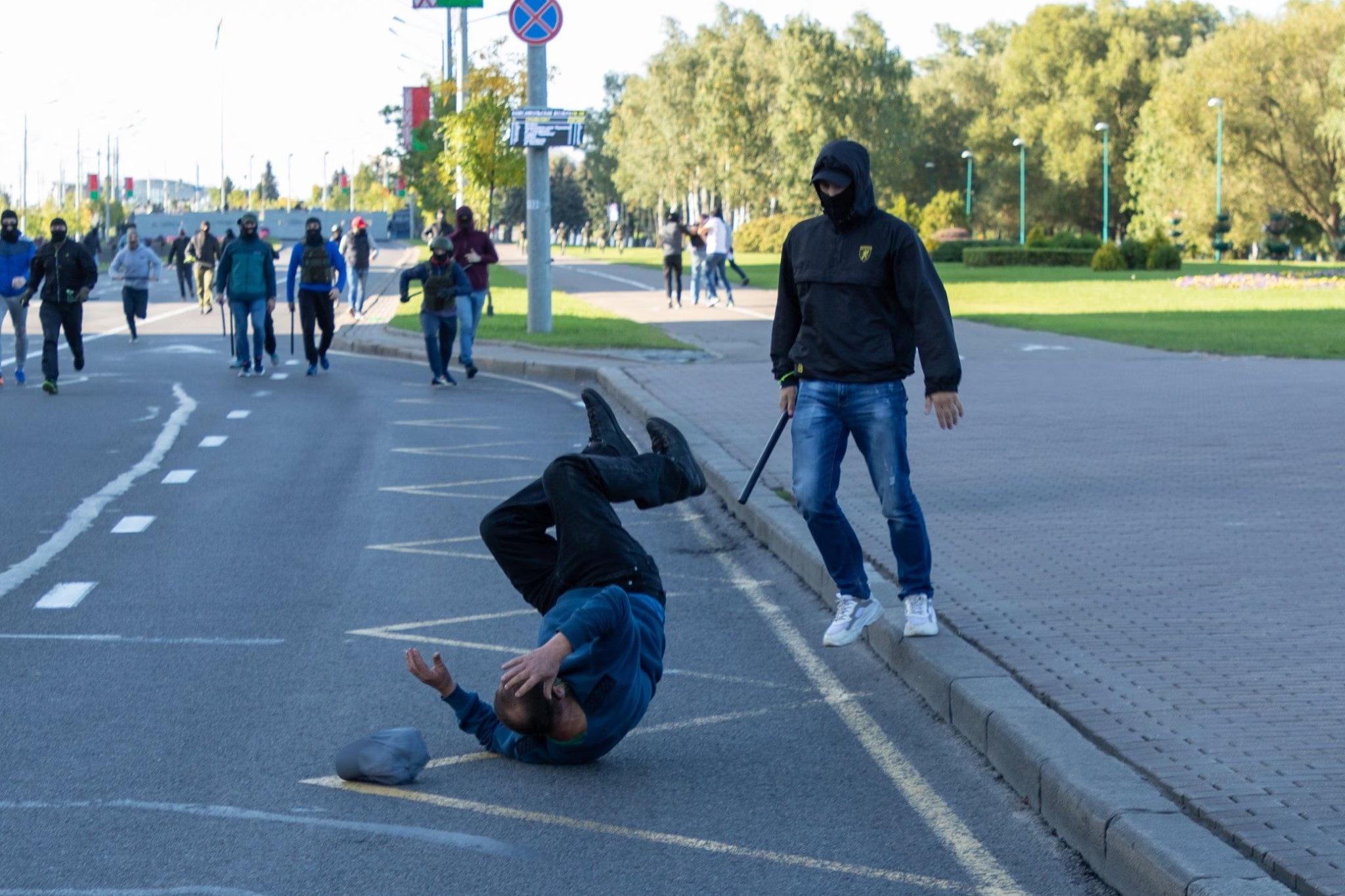
Minsk during peaceful protests in 2020. Photo: Henadz Veratsinski
How many times have you been detained?
Counting only serious cases, four times.
What was your initial desire then? Was it to conceal your SIM card and camera? Or perhaps you tried taking some photos?
I even shot in courtrooms, for instance, during hearings of yet another case involving Liabedzka. It was already forbidden at that time, but I was able to get a permit from the judge. Anatol’s entire speech was recorded on film, making it an essential historical document. By the way, he was acquitted in that episode.
A similar thing happened once in Astrashytski Haradok. The police stopped us and began an inspection. I calmly took out my camera and started shooting them. They were stunned by the unexpected audacity and let us go.
My professional stress isn’t fear; it’s the knowledge that something could happen at any moment. Despite my outward calm, a thin thread still flutters inside.
What about other photojournalists who worked at opposition rallies where security forces were always nearby? There have been cases where they were beaten, imprisoned, and had their equipment smashed. Have the police ever fought with you or blocked you from taking good shots?
First of all, they attempted to prevent the documentation of their crimes. We have been punished for bearing that photographic truth.
I’ve never worn a vest with the word “Press” on it or carried any kind of passes. I didn’t reveal my identity as a journalist. I was just walking around taking pictures. There’s a saying: A photographer should be like a shadow — or better yet, an invisible man — so they can’t be seen or heard. You should be everywhere.
When you start showing any kind of distinctiveness — even through supposed neutrality — you immediately attract attention. And it only gets in the way.
What about those who did the opposite?
Even in the past, they often got the full treatment. I first saw a broken camera back in 1996 when cars were overturned. A Betacam flew up and crashed onto the asphalt. An expensive thing, it’s a pity.
For the editorial office, it’s just a loss — but for the photographer, perhaps it means something more?
It is a personal tragedy. After all, a camera is like an extension of your hands. It’s a part of you.
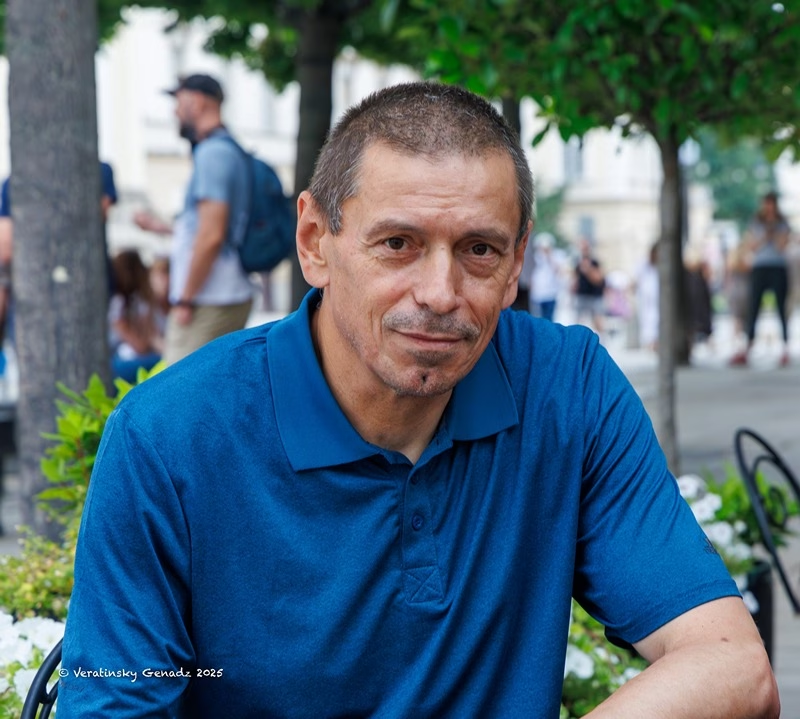
Former political prisoner Ihar Karney. 2025. Photo: Henadz Veratsinski
What happened in 2020? How did you end up in Poland?
The last rallies were held in December. Our backyard, near Chkalava Street, was the site of neighborhood protests. As usual, I went to take pictures. Suddenly, the police arrived. There were cadets from the militia school dressed in green with batons. I shot it. They rushed toward me, grabbed the camera, and took me to the Maskouski District Police Department. I tried to resist. “I’m a journalist. I’m just taking pictures,” and so on. “You’re shooting everything the wrong way.” I tried another approach because I really felt unwell in those days, and I wasn’t trying to deceive them: “I feel bad. I have high blood pressure.” “Me too.” They didn’t even call an ambulance. On the contrary, they took me directly to hell, the Minsk detention center. I got really dizzy, and they kept saying, “According to the report, your vitals are normal!” In the end, they had to take me directly from the detention center to the hospital, where I was pumped out.
After that, they stopped bothering me for some time. But this was short-lived. The Investigative Committee started calling, and subpoenas arrived in the mail. The choice was simple: either go to jail or leave. I moved to Georgia in May 2023 and applied for a humanitarian visa. By July, I was already in Warsaw. Now my apartment in Minsk is sealed by the Investigative Committee. That indicates that a case has been opened.
If you count them — how many rallies, demonstrations, and community meetings have you photographed over the years?
Hundreds. Dozens every year.
When I started taking pictures, it was just out of interest. But gradually I came to understand: you can’t live your life on “neutral ground.” Neutrality is fake. You have to take a side — the one that aligns with your conscience. In your judgments about life, you should remain calm, but in life itself, you’re either with the whites or the reds.[7] Changing positions isn’t an option.
It’s a bad sign when a person thinks they’re above everything.
That only happens when they’ve stopped feeling anything at all.
The project “Voice of the Freedom Generation” is co-financed by the Polish Cooperation for Development Program of the Ministry of Foreign Affairs of the Republic of Poland. The publication reflects exclusively the author’s views and cannot be equated with the official position of the Ministry of Foreign Affairs of the Republic of Poland.
[1] Derogatory word used to describe people clinging to Soviet mentality after the collapse of the USSR.
[2] Bulat Okudzhava was a Soviet and Russian poet, writer, musician, novelist, and singer-songwriter of Georgian-Armenian ancestry. He was one of the founders of the Soviet genre called “author song”, or “guitar song”, and the author of about 200 songs, set to his own poetry.
[3] A Potemkin village is an impressive but fake facade designed to hide an undesirable reality or a bad condition. The term refers to any construction, either literal or figurative, that is built to deceive and impress, often used in politics, economics, or public relations to create a misleading impression of prosperity or success.
[4] In 2006, protesters established a camp on Kastrychnitskaya Square in Minsk and renamed it Kalinouski Square, in honor of Kastus Kalinouski — a symbol of the Belarusian struggle for peasant freedom during the 1863 Uprising.
[5] The Battle of the Niamiha River, fought on March 3, 1067, was a conflict from the feudal period of Kievan Rus’. Its description marks the first mention of Minsk in historical chronicles. The interviewer draws a parallel between this battle and the clashes between protesters and riot police during the Chornobyl March.
[6] Nina Bahinskaya is a life-long Belarusian human rights activist, public figure, and geologist. She was detained dozens of times by police and spent many days in temporary isolation cells. The cumulative fines that Bahinskaya owes to the government for her participation in hundreds of protests account for tens of thousands of dollars.
[7] A reference to the Russian Revolution in 1917 and the civil war between the tsarist troops (the whites) and the socialist units (the reds).
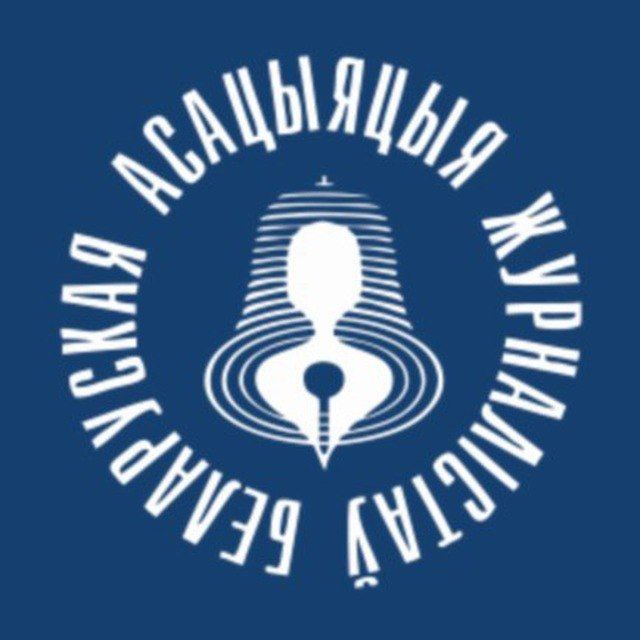 @bajmedia
@bajmedia
